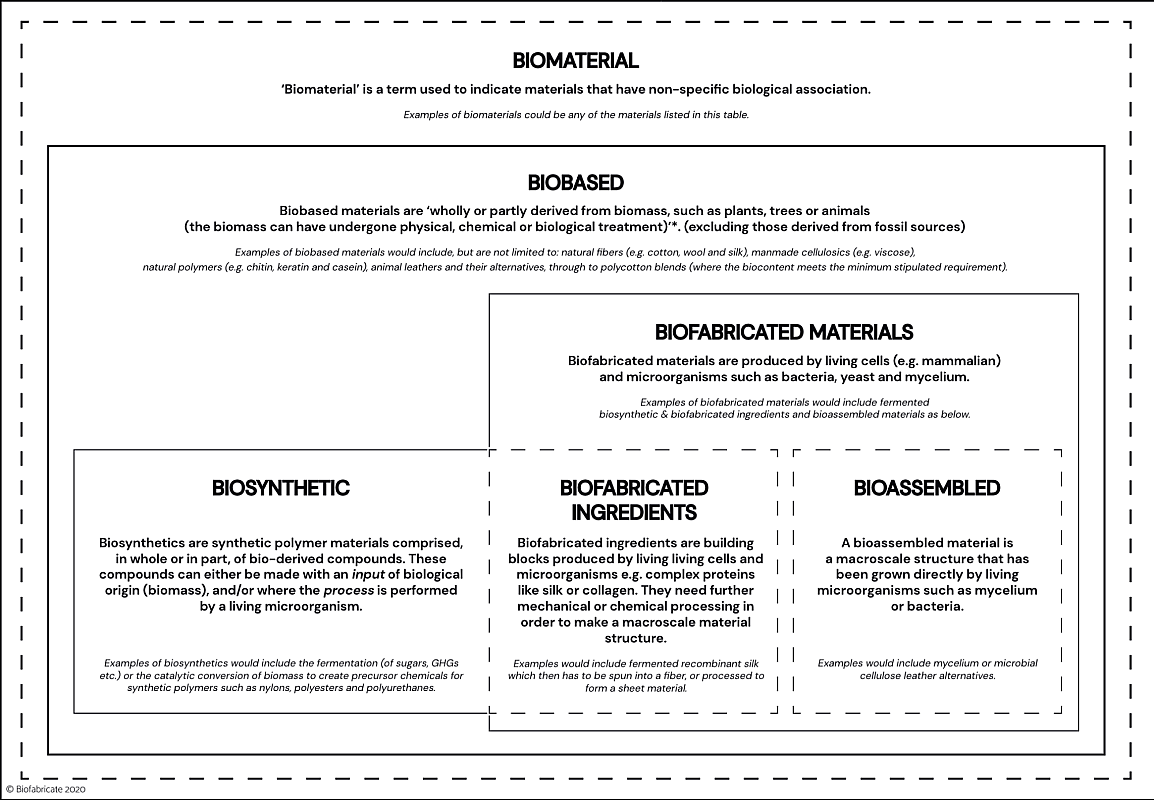BLOG
July 20, 2022
Forging a Post Petroleum World: Biobased, Biofabricated, Biomaterial, What’s the Difference?
We’re bringing you the latest research from our materials researchers in a new blog series, From the Library Drawers.
As architects and designers, we are aware that our material choices can bring toxics to people’s lives, trigger CO2 emissions and contribute to the climate crisis. So we’re constantly looking for alternatives to conventional petrochemical-based and toxic products. Better building products are those that are made from plant and mineral-based ingredients. But how will we know that these new “Bio” products are better?
It seems like every day, a new innovative building product hits the market. From the straw you’ll use at your local coffee shop to the new handbag you saved up for, it’s hard to go anywhere and not see things that are “Bio.” But what does Bio mean? And beyond that, is Biobased the same thing as Bioassembled? And is that the same thing as a Biomaterial? The short answer is no. All of those terms have different definitions. We’re going to dig deeper and give you a longer, more satisfying answer.
The fact is, the majority of these words have not been standardized and have no legal definition. You might know that a company cannot use the word “organic” without having their product be certified as an organic product with organic processes. That process hasn’t happened for many things made from biological sources, and it makes their definitions harder to pin down.
Of course, biomass as a material source has promising potential. Moving away from crude oil is definitely a step in the right direction. Yet, we cannot assume that these materials have solved all of the issues created by plastics made from crude oil. So, while we are intrigued by new material developments, we remain cautious and advocate for material transparency. Open, transparent material ingredients declarations will give us the confidence to understand whether bioplastics are a viable solution to the current plastics problem.

Duracryl Corque Liquid Lino, a bio-based material made with linseed and castor oils.

Loliware contains 100% bio-based content according to Bioprefered.gov

AlgiKnit is a bio-based yarn made from biopolymers sourced from algae.

Carnegie Xorel Fabrics, a bio-based textile using ingredients from sugarcane.

Polaris Renewables is developing bio-based non-isocyanate polyurethanes (NIPUs) for use in foams, coatings, and adhesives.

Mogu Flooring, a biofabricated material using mycelium sources.

MycoComposite by Ecovative is a biofabricated alternative to plastic foam packaging and insulation using materials made with mycelium and non-food agricultural waste.

Bolt Threads' Engineered Silk is biofabricated by mimicking the DNA in Spider Silk.

Mycoworks leather is a bioassembled material. It is rapidly grown from mycelium and agricultural by-products in a carbon-negative process.

bioMASON's tiles are bioassembled using technology similar to hydroponics - units mixed with microorganism are fed an aqueous solution to harden the tiles to specification.
Biomaterial is the broadest term. It simply means any material that has a biological association. Because the definition is so broad, it can fit almost any material.
Bio-based is the only term on this list that does have a legal definition. It has been defined by the United States Department of Agriculture and the European Union. It refers to products wholly or partly derived from biomass. That biomass can come from sources like plants, fungi, or animals. But it’s important to note that there are different minimum percentage requirements for different product categories. According to the USDA, bio-based carpet needs to have only 7% bio content and fibers and fabrics are required to have a minimum of only 25% bio content. This is why many bio-based materials are still mostly synthetic content.
Biosynthetic/Bioplastic materials are synthetic materials made from a biological source. These materials often claim to be “healthier” replacements for traditional plastics made from crude oil. But some bioplastics are made by converting biomass into plastics that are chemically identical to those derived from crude oil. For example, sugarcane could be converted into a compound which is then further transformed into a polymer - but the result is a substance that is chemically identical to a polymer made from fossil fuels. A product labeled bioplastic may still be just a small percent from a biological source. There is no standard or legal definition.
Biofabricated materials are made by growing living cells and microorganisms such as bacteria, yeast, and mycelium. There are two categories of biofabricated materials: The first are materials made with ingredients that are biofabricated. For example, a bacteria could produce a dye and that dye could be used on a fabric. The fabric is not necessarily biofabricated, but because the dye is, the garment may be labeled “biofabricated” yet it is only partially biofabricated. The second are bioassembled materials which are directly grown from a living microorganism, such as an acoustic panel that is entirely made of mycelium.

"Defining Bio" from Biofabricate's Understanding Material Innovations 2020 report.
Special thank you to Biofabricate for putting together this diagram on bio-materials for their Understanding Material Innovations report.
See our Material Collection: Biofabricated Materials
See our Blog Post: What Does the Bio-Preferred Label Mean?
Read More
Join Our Academic Network
Get Access to our carefully researched and curated academic resources, including model syllabi and webinars. An email from an academic institution or a .edu email address is required. If your academic institution does not use .edu email addresses but you would like to join the network, please contact healthymaterialslab@newschool.edu.
Already have an account? Log in